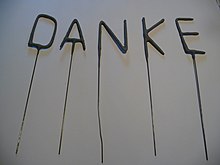Sparkler
A sparkler (synonyms: asterisk fire , Sprühkerze , spray candle , star splashes , Sparkler , Star Pucker , Star sprayer , star sprayer , star splashes , Spautzemännchen , Sternschneuzer , Sternlespeier , Sterndrachetle ; English: sparkler , electric sparkler ) is a spark sparkling, mostly bar-shaped fireworks , which in the Can be hand held.
construction
A sparkler consists of a copper-plated steel wire on which a 4 mm thick layer of burning is applied. The burning layer consists of about 50% of the oxidizing agent barium nitrate , about 30% of iron powder , about 10% of aluminum powder and about 10% of binding agent. Dextrin , flour or potato starch are used as binding agents. The grain size of the metal powder is decisive for the characteristic spark spray. The choice of metal powder determines the color of the sparks. Aluminum, titanium or magnesium produce white, iron orange and ferro-titanium yellow-gold sparks.
Common lengths of sparklers are 30, 40 and 70 cm as well as "giant sparklers" with a length of 1 m.
reaction
The sparks typical of sparklers are created when the tiny iron granules burn with oxygen . In addition, some metal grains are thrown away from the sparkler by the gases produced when the starch ( and ) is burned and the barium nitrate ( ) decomposes . The combustion takes place according to the following reactions.
The chemical reaction in a sparkler generates temperatures of up to 1100 ° C. The gases produced during the burning reaction contain poisonous carbon monoxide and nitrogen oxides .
Sparklers also burn in an inert gas atmosphere or as a bundle under water.
Manufacturing
A doughy fuel is produced from the oxidizing agent, the metal powders and the binding agent together with water. This is applied to the metal rods and then dried.
use
Sparklers are also suitable for spectacular presentations when serving food. The television series " The Dream Ship " often makes use of this effect at the end of the film.
Sparklers can practically not be blown out, so they are suitable, for example, for visualizing the trajectories of boomerangs .
history
The history of the invention of the sparkler is not clear. According to some sources, e.g. B. BBC e-cyclopedia, sparklers were invented by Kallinikos of Heliopolis around 670 AD. He was an architect and called his invention 'Cherosiphon' which was more like a small Roman torch. The oldest patent that has been found so far is AT000000035606B, “Process for the production of a spark-spraying light stick”, Franz Jacob Welter, United Sparkler Factory Limited Liability Company, Hamburg, 1907.
The production of sparklers was initially the only basis of the well-known German fireworks factory WECO Pyrotechnische Fabrik GmbH.
Legal classification in Germany
Sparklers up to a length of 30 cm are category 1 fireworks (so-called miniature fireworks ), which can be given out all year round, even to people under the age of 18. The European standard EN 71 "Safety of toys" prohibits distribution to children under 3 years of age.
Sparklers with a length of 40 cm (burning time approx. 2 minutes) and 70 cm (burning time approx. 3.5 minutes) belong to the category T1 fireworks, which can also be given and used all year round, but only on and by people above 18 years and only for technical purposes in accordance with the instructions for use.
The giant sparklers with a length of 1 m (burning time approx. 5 minutes) are category 2 fireworks (so-called small fireworks ), which are generally only given to people aged 18 and over on the last three working days of the year and only on 31. December / January 1st ( New Year's Eve and New Years ). Use outside of this period is only permitted with an official permit to burn down fireworks in the form of an exemption from the prohibition of use in Section 23 (1), 1st half-sentence in accordance with Section 24 (1) of the 1st Ordinance on the Explosives Act (1st SprengV). Training as a pyrotechnician is not required for this.
See also
swell
- ↑ What is the "fuel" of a sparkler? In: COSMiQ . ( cosmiq.de [accessed on December 25, 2016]).
- ↑ Sparkler compositions. December 21, 2015, archived from the original on December 21, 2015 ; Retrieved December 25, 2016 .
- ↑ Sparklers Can Burn at 2,000 Degrees Fahrenheit. United States Consumer Product Safety Commission, accessed December 25, 2016 .
- ↑ Sparklers under water - chemistry experiments - netexperimente.de. (No longer available online.) In: netexperimente.de. Archived from the original on October 21, 2016 ; Retrieved December 26, 2016 .
- ↑ Peter Wich: Experiment - No. 029 sparklers. In: www.experimentalchemie.de. Retrieved December 26, 2016 .
- ↑ http://www.feuerwerk-forum.de/showpost.php?p=114436&postcount=8
- ↑ Definitions of the classes ( Memento of December 26, 2008 in the Internet Archive )
literature
- Christina Martin, Tönjes de Vries: The chemistry of the sparkler - a topic not only at Christmas time. In: CHEMKON 11 (1), 2004, ISSN 0944-5846 , pp. 13-20









